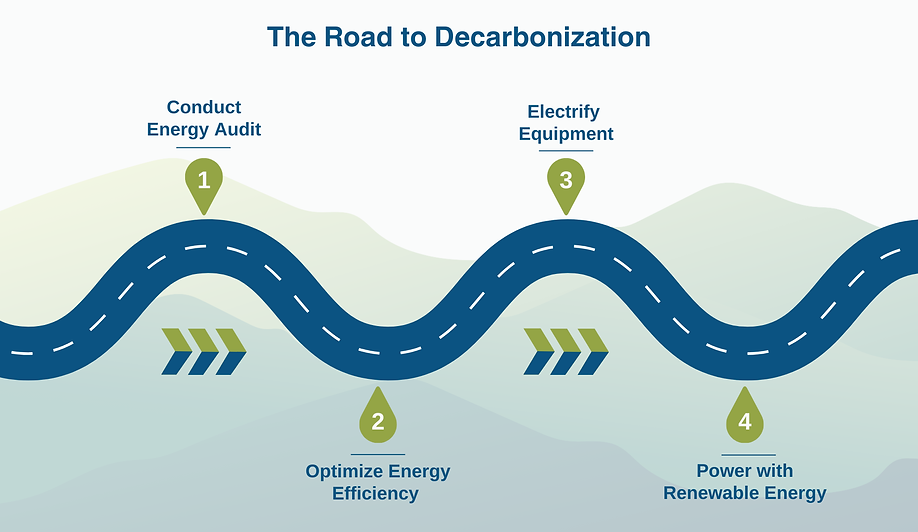IMPLEMENT: VINEYARD ENERGY EFFICIENCY & RENEWABLES
Energy Use in Vineyards
The combustion of fossil fuels during the operation of tractors, ATVs, irrigation pumps, and other farm equipment constitutes a large source of the vineyard carbon footprint. As such, reducing fuel and electricity usage is one of the most effective ways to reduce the vineyard carbon footprint and help mitigate climate change. Reducing energy use is also good for the bottom line since it reduces energy costs and conserves natural resources.
Priority Practices Quick Links:
-
Power with Renewable Energy
The Goal of Decarbonization
One of the main objectives of climate action is decarbonization (using carbon-free renewable energy sources for all energy needs). To achieve decarbonization, first overall energy use must be reduced and optimized, wherever possible equipment should be powered with electricity and renewable energy such as solar and wind should be used. Technology advances are still needed to efficiently electrify all farm equipment, however, there are many steps outlined below that can move your vineyard operation closer to decarbonization.
.png)
1. Conduct an Energy Audit
Before installing any renewable energy or implementing energy efficiency measures, an energy audit should be conducted. The intent of an energy audit is to assess energy-consuming processes and equipment and to compile a list of potential changes in behavior or technology that can reduce overall energy consumption. Once energy consumption is minimized, then renewable energy options can be explored that will meet the vineyard’s energy needs, which can prevent added costs from installing renewable energy systems that provide more energy than needed.
The three main uses of energy in vineyard operations include the irrigation system, farm vehicles and tractors, and lighting of structures and outdoor task areas on the property (non-winery structures). Use the following resource to assess your energy related practices, prioritize potential opportunities and learn about resources for cost-share, rebates and incentives.
2. Optimize Energy Efficiency
Once you have completed an energy audit, you can prioritize potential opportunities for efficiency. Energy efficiency practices for vineyards fall primarily into three categories: irrigation pump, vineyard vehicles and lighting. Since irrigation pumps are the one of largest sources of energy use it is important to ensure pumps are operating efficiently. An inefficient pump will use more energy than normally required and may not supply the pressure and flow appropriate to the demands of the pumping system. The result could be poor distribution uniformity and poor irrigation efficiency, leading to more water being pumped to fully irrigate the vineyard, which can impact winegrape quality and quantity.
The following list of potential improvement areas are shown in order from highest impact on energy use to lowest to help with prioritization. Include relevant practices in Climate Action Plan Worksheet to help track practices and create timelines for implementation. You can also run the CSWA Climate Smart Report to easily identify which energy efficiency practices are already implemented and where there are improvement opportunities.
-
Irrigation Pump Efficiency
-
Vineyard Vehicles
-
Lighting
-
Office Equipment
3. Electrify Equipment
As noted above, a large source of the vineyard carbon footprint is from combustion of fossil fuels for operation of vineyard vehicles and equipment. To decarbonize mobile and stationary field equipment, the equipment needs to be powered with electricity that can be sourced from renewable energy. Electrifying vineyard vehicles and equipment is one area that needs more research and advancements in technology, however there are some promising options available along with financing assistance.
4. Power with Renewable Energy
Many vineyards and wineries install solar panels as part of their renewable energy strategies, with a growing number adding batteries for storage. Installing solar photovoltaic panels can be a great investment, especially as electricity costs continually increase. There is also currently a Federal Tax Credit that covers 30% of the cost of solar. There are more options for incorporating renewable energy into your operations than rooftop solar panels. You can also explore innovative technologies powered by the sun to pump water.

-
Vineyard Energy Efficiency & Renewables - Implementation Guide: The guide outlines key practices and resources to support implementation of an energy audit, energy efficiency measures for irrigation pumps, vineyard vehicles, lighting and office equipment, and renewable energy, along with cost-share, rebate and incentive opportunities to help finance energy efficiency upgrades and renewable energy.
